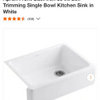clarification on hydronic toe kicker heater
jtwindad
14 years ago
Hi all,
New here. Just ripped out my kitchen and putting cabinets in. This means the radiator in the room is now gone. So I am going to use a toe kick heater. I am debating between hydronic (Turbonics 6/8) or an electric. I currently have radiators with a natural gas boiler. I live in Richmond, VA so it gets cold, but not that often. The house is 1950 brick on block construction - no insulation but I will be putting the pink styrofoam panels between the furring strips on the 2 outside walls, 2 windows - single pane no storm.
Originally I thought hydronic was a no brainer - just tie into the existing heater lines....until I talked to the guy at Turbonics - he said that the flow rate in my existing single line closed system is not enough for the kicker - it would cool to fast. I would have to add another circulator pump (Taco 006) at the boiler and run new lines for it's own system. This just got more complicated and expensive!!! The boiler is also about a 40 feet total run from where the kicker will be. So I am looking at a new pump, 100' pex (supply and return), and what ever check valves and such that I need... Really making electric sound easier and cheaper. The room is 14x11 and our stay in this house is 5-7 years max. What to do?
Thanks,
Joe




funyellow
kaseki
Related Professionals
Fresno Kitchen & Bathroom Designers · Philadelphia Kitchen & Bathroom Designers · Saint Peters Kitchen & Bathroom Designers · Olympia Heights Kitchen & Bathroom Designers · Hickory Kitchen & Bathroom Remodelers · Newberg Kitchen & Bathroom Remodelers · Vienna Kitchen & Bathroom Remodelers · Gaffney Cabinets & Cabinetry · Hammond Cabinets & Cabinetry · Key Biscayne Cabinets & Cabinetry · Vermillion Cabinets & Cabinetry · University Park Cabinets & Cabinetry · Saint James Cabinets & Cabinetry · Lake Nona Tile and Stone Contractors · Rancho Mirage Tile and Stone Contractorstengofive
jtwindadOriginal Author
kaseki
andyman